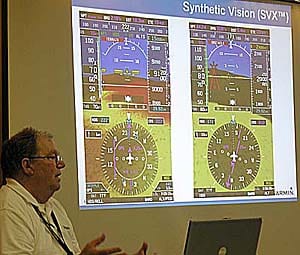Dan Johnson, president of the Light Aircraft Manufacturers Association, is an expert on Light Sport Aircraft.
Tim Casey is just plain full of it. Garmin‘s jovial, well-recognized manager of the instrument company’s aviation hand-held and LSA line of avionics products is one knowledgeable character. In fact, he is so full of information that his one-hour seminar at the Midwest LSA Expo only scratched the surface of the seemingly limitless capabilities of the company’s digital instrument line. For example, synthetic vision comes preinstalled on the G3X and if you want, the Garmin unit can even be wired to show the closure of doors.
I enjoyed his review of the Garmin G3X line used in some LSA and plenty of homebuilt aircraft. It’s a deluxe system that costs $14,500 for the full dual-screen unit… BUT, if you act before the end of 2010, you can secure a whopping 25% discount, saving you $3,600.
 Garmin also makes the increasingly common GPSMap 696 or the 496 used in a large number of LSA. In his talk, Tim touched on those products and the handheld Aera, my personal favorite with its touchscreen interface that works similarly to my iPhone.
Garmin also makes the increasingly common GPSMap 696 or the 496 used in a large number of LSA. In his talk, Tim touched on those products and the handheld Aera, my personal favorite with its touchscreen interface that works similarly to my iPhone.
In a comment certain to warm the heart of a pilot, Tim noted, “The software engineers as well as the hardware, mechanical, and systems engineers behind the company’s G3X systems are all airplane builders.”
In a similar vein, he explained that Garmin stitches together features from many other databases including maps, of course. “We have no less than 45 cartographers to handle these duties,” Casey added.
G3X comes with all engine software preinstalled for the Rotax, Jabiru, Continental, and Lycoming. Of course, you’ll need the correct engine probes and sensors — the same as any engine gauge, even an analog gauge. In addition, Garmin recently added a fuel calculator to speed awareness of this important parameter. And, the GPS giant added the opportunity to create several checklists; you build your own using your laptop or desktop computer.
In one hour, Tim could not possibly review all the features of Garmin avionics, which explains why you really need to visit Garmin’s mini-website for these devices.
For more on Sport Pilot and LSA: ByDanJohnson.com

Dan:
Nobody will dispute the effectiveness of Garmin’s amazing technology – I have a Garmin stack with a Garmin 480 and MX20 in my plane, now with Aspen PFD and MFD as well – it’s an exciting panel – but Garmin rocked us to the core when it discontinued the 480 and recently chose to cease offering repair facilities on the 28V Garmin 430 and 530 units. This displays a trend that indicates that Garmin is dumping state of the art units to persuade their customers to purchase new units, and the time frame seems to be 18 years from new to totally obsolete. Owners of 28V 430 and 530 units have units that can be used only for parts now, and this is disturbing people who have invested heavily in Garmin equipment.
I love what Garmin has developed, but I loathe their questionable support and the stand alone attitude where they will not upgrade technology to existing units. The GMX200 is still state of the art, but Garmin won’t provide weather, not synthetic vision to it, requiring that you dump it and buy a Garmin 300X or G500 or 600 of you want synthetic vision.
I would choose another brand if similar technology is available. Aspen has pledged to support its customer base through technology upgrades, where Garmin does nothing. I’m thrilled with my Aspens (note that I still have the Garmins) but I won’t buy Garmin if I can avoid it).
You might look at the Avidyne equipment for experimental aircraft – you be surprised at what you find in capability and price.
Pat